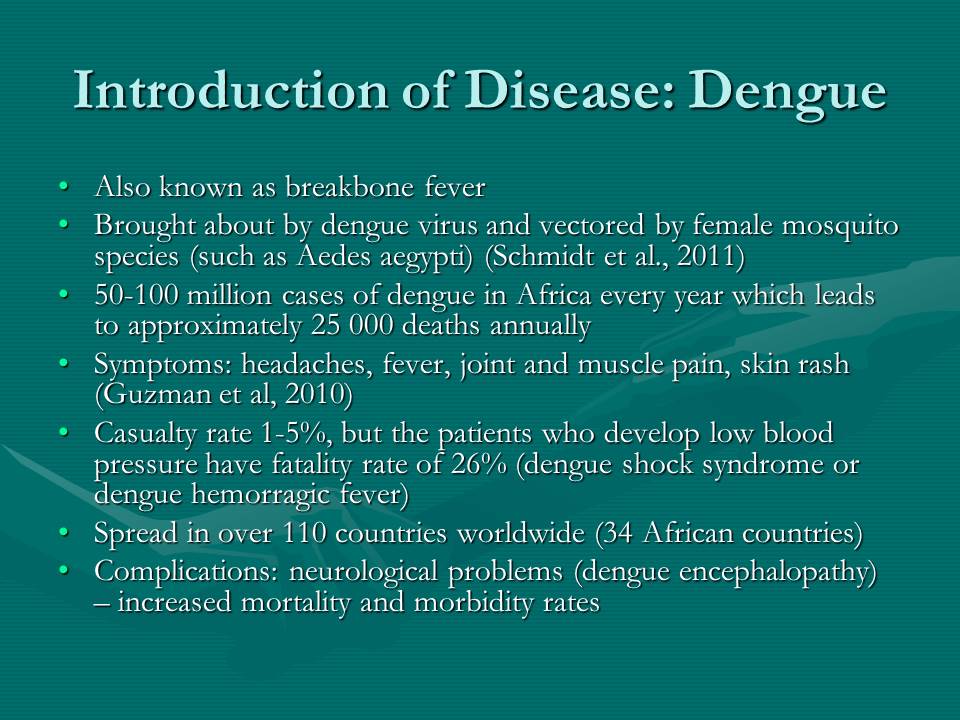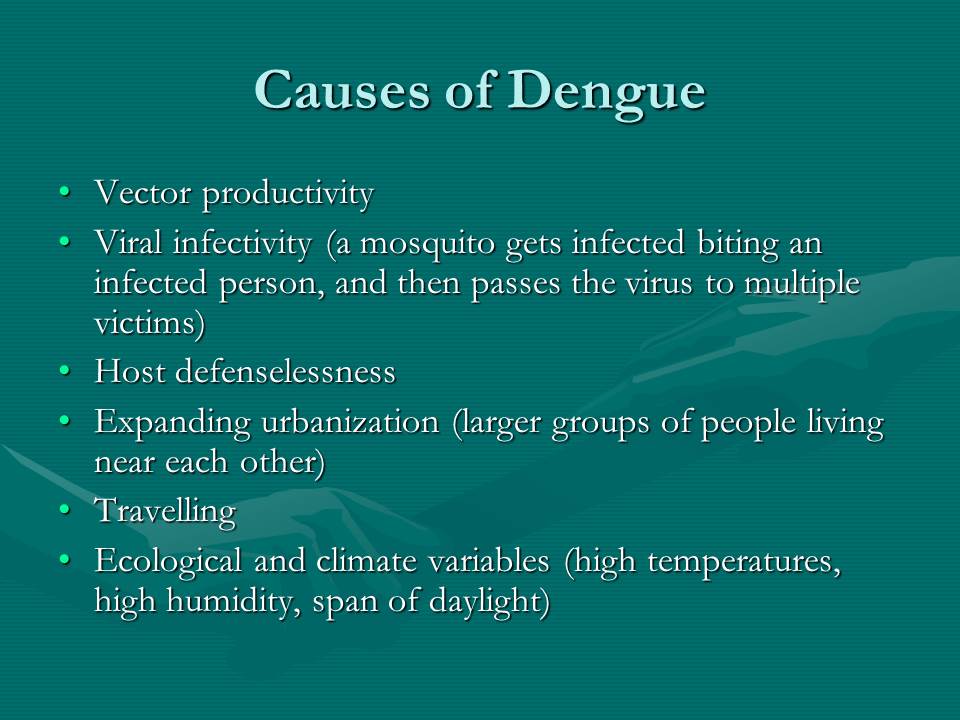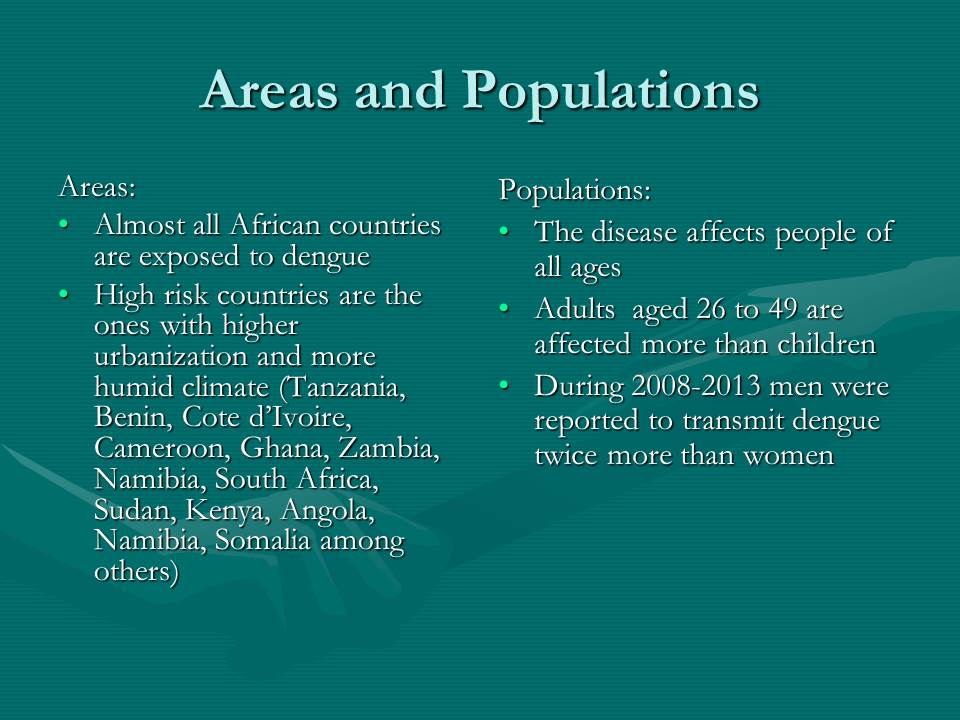Introduction of Disease: Dengue
- Also known as breakbone fever.
- Brought about by dengue virus and vectored by female mosquito species (such as Aedes aegypti) (Schmidt et al., 2011).
- 50-100 million cases of dengue in Africa every year which leads to approximately 25 000 deaths annually.
- Symptoms: headaches, fever, joint and muscle pain, skin rash (Guzman et al, 2010).
- Casualty rate 1-5%, but the patients who develop low blood pressure have fatality rate of 26% (dengue shock syndrome or dengue hemorragic fever).
- Spread in over 110 countries worldwide (34 African countries).
- Complications: neurological problems (dengue encephalopathy) – increased mortality and morbidity rates.
The rates of dengue awareness in the world are rather low due to the fact that there are other widespread diseases similar to dengue. Malaria is a good example of such disease. The researchers focus on malaria and ignore the growing rates of dengue as these diseases have similar symptoms. Many dengue patients end up getting treatment for malaria to which they do not respond. Lack of systematic surveillance and testing results in thousands of unrecognized cases of dengue and rapid growth of the number of affected individuals every year.

Causes of Dengue
- Vector productivity.
- Viral infectivity (a mosquito gets infected biting an infected person, and then passes the virus to multiple victims).
- Host defenselessness.
- Expanding urbanization (larger groups of people living near each other).
- Travelling.
- Ecological and climate variables (high temperatures, high humidity, span of daylight).
The disease spreads especially rapidly during the stormy seasons when dampness, winds and rains lead to the maximization of the population of mosquitoes. Urbanization is a powerful factor which participates in the disease transmission as it gathers larger numbers of people in certain districts where they become infected quickly over short periods of time. Individuals with lower immunity are easy targets for the disease as they end up getting worse outcomes.

Areas and Populations
Areas:
- Almost all African countries are exposed to dengue;
- High risk countries are the ones with higher urbanization and more humid climate (Tanzania, Benin, Cote d’Ivoire, Cameroon, Ghana, Zambia, Namibia, South Africa, Sudan, Kenya, Angola, Namibia, Somalia among others).
Populations:
- The disease affects people of all ages;
- Adults aged 26 to 49 are affected more than children;
- During 2008-2013 men were reported to transmit dengue twice more than women.
Travelers are known to be one of the causes of the spread of dengue plagues. One infected person moving around is capable of exposing whole villages and towns to the disease epidemics due to the host defenselessness.

Unreported Danger
- The World Health Organization has admitted that dengue is of seventeen disregarded tropical diseases today;
- Rates of dengue infection increased by 30% within the period between 1960 and 2010;
- This threat is ignored due to the existence of other similar widespread diseases;
- Perceived prevention measures: vector control, education of African population;
- Funding is required to enforce surveillance, report, research and data collection.
The threat that kills around 25 000 people only in Africa every year can no longer be ignored by the world’s health organizations and healthcare providers. With the proper funding a thorough research can be conducted and valid qualitative and quantitative data concerning the rates of infection will be collected. Besides, in order to address this threat vector control measures can be implemented and a suitable treatment will be developed. This will save thousands of libes not only in Africa but also in South Asia and Latin America which also suffer from dengue infection.

Reference List
Guzman, M., Halstead, S., Artsob, S., Buchy, P., Farrar, J., Gubler, D., . . . Peeling, R. (2010). Dengue: a continuing global threat. Nature Reviews, 12(2), 7-16.
Schmidt, W., Suzuki, M., Thiem, V., White, R., Tsuzuki, A., Yoshida, A., Yanai, H., . . .Ariyoshi, K. (2011). Population density, water supply, and the risk of dengue fever in Vietnam: Cohort study and spatial analysis. PLoS Medicine, 8(9), 1-10.